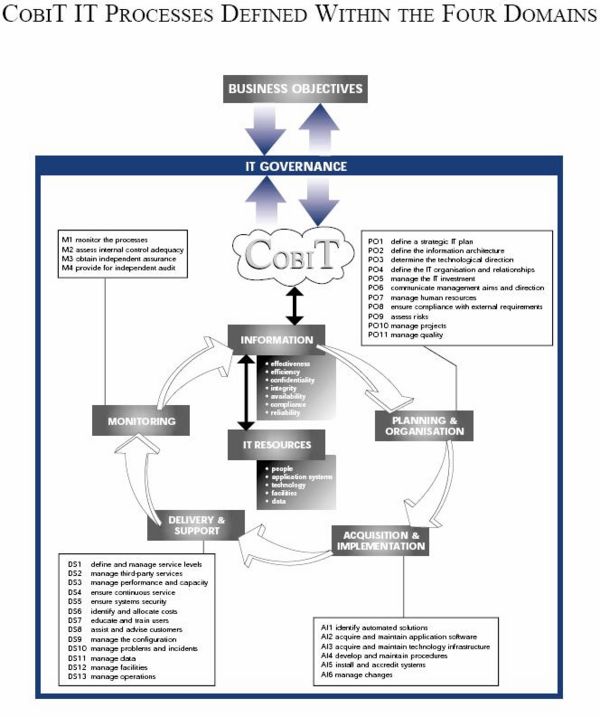Problem/Issue
Statement
 Accenture is a management consulting, technology
services and outsourcing company helping clients become high-performance
businesses and governments. The company faces a decision pertaining to
the future of their IT infrastructure: whether to adopt CORBIT 5 IT standards
that have the potential to recognize Accenture as a world class organization,
or continue with the current single, global infrastructure that proved to be
effective and efficient from the operational as well as financial standpoint.
Accenture is a management consulting, technology
services and outsourcing company helping clients become high-performance
businesses and governments. The company faces a decision pertaining to
the future of their IT infrastructure: whether to adopt CORBIT 5 IT standards
that have the potential to recognize Accenture as a world class organization,
or continue with the current single, global infrastructure that proved to be
effective and efficient from the operational as well as financial standpoint.
Scope of the decision includes entire operations network for
Accenture and its IT infrastructure across all company locations. The Company’s
IT structure had always promoted streamlining operation within the organization
and served as an example for all their clients. Since Accenture operates in a field that is
constantly changing and evolving the operational conditions pose many
challenges, which are ultimately symptoms of a developing environment.
Situation Assessment
Accenture’s IT structure evolved from managing technology with
a decentralized approach, in which each country chose its own IT platforms and
had autonomy to run them, to a ‘one-firm’ approach with centralized implementation
of its most critical systems. IT became a business within a business of the
company. It transformed from being a cost center to a service organization
conceived and driven by the needs of internal customers and stakeholders. It presented
clear and verifiable service levels for each of the IT products and services
offered while remaining competitive. The company’s fee structure is based on an
established level of service on a transactional basis rather than on a periodical
fixed fee schedule. Accenture chose Microsoft as a partner to have a single platform
and common global applications that reduced overall expenditures and allowed
for flexibility to grow though scalability. Microsoft provided Windows NT to
run Accenture’s server and network infrastructure as well as SQL database for
all data related tasks. Microsoft Outlooks is used for email together with
various application provided by the Office Suite products. The Company chose
SAP as its worldwide application provider for financial and human resources
solutions. Accenture divided various activities into buckets and rationalized
IT needs opting for outsourcing of services that are not highly confidential or
differentiated competitive core. Any projects are considered based on ROI
measures and alliance with corporate strategic objectives.
Such radical changes, although followed by tremendous
success and economies of scale, were met with pushback from various levels of
the organization. The decision to implement a new IT framework raises further
questions of competitive sustainability in globally operated consulting
industry. Accenture needs to evaluate whether the implementation of a new framework
is aligned with the goals and focus of its IT functions.
List of Plausible
Alternative Courses of Action and Evaluation of Alternatives
The plausible alternative courses of action for Accenture
include:
 1) Forgo the decision of implementing any changes
and focus on maintaining IT function that proved to be very successful through
the IT infrastructure outsourcing, continue using single global vendor and
accountability schemed for all IT initiatives. Accenture went through a journey
of successfully transforming its IT capabilities. The Company more than doubled
its workforce in size from 2001 to 2008. The IT organization managed to reduce spending
per employee by 60% and reduce overall IT expenses as a percentage of net revenue
by 58%. At the same time, the overall satisfaction of Accenture professionals
with the IT tools and services is increasing.
1) Forgo the decision of implementing any changes
and focus on maintaining IT function that proved to be very successful through
the IT infrastructure outsourcing, continue using single global vendor and
accountability schemed for all IT initiatives. Accenture went through a journey
of successfully transforming its IT capabilities. The Company more than doubled
its workforce in size from 2001 to 2008. The IT organization managed to reduce spending
per employee by 60% and reduce overall IT expenses as a percentage of net revenue
by 58%. At the same time, the overall satisfaction of Accenture professionals
with the IT tools and services is increasing.
2) Take the IT infrastructure to a higher level by
implementing COBIT – Control Objectives for Information and Related Technology –
a framework created by ISACA for information technology management and IT
governance that defines a set of generic processes to manage IT. COBIT is a
supporting toolset that allows managers to bridge the gap between requirements,
technical issues and business risk. It
is based on 5 key principles for governance and management of enterprise IT:
2) Covering the
enterprise end-to-end,
3) Applying a
single, integrated framework,
4) Enabling a
holistic approach, and
5) Separating
governance from management.
The COBIT components include:
a. Framework – organize IT governance objectives
and good practices by IT domains and processes, and links them to business
requirements,
b. Process descriptions – a reference process model
and common language for everyone in an organization; the process map to
responsibility areas of plan, build and run monitor,
c. Control objectives – provide complete set of
high-level requirements to be considered by management for effective control of
each IT process,
d. Management guidelines – help assign
responsibility, agree on objectives, measure performance, and illustrate interrelationships
with other processes,
e. Maturity models – assess maturity and capability
per process and helps address gaps.
Each alternative needs to be evaluated not only from a cost
perspective but also from a future benefit potential. CORBIT 5 implementation
could have a potential to increase revenue by acquiring new customers
interested in adoption of such a standardized framework. The framework offers
further control and accountability, which can ultimately help the bottom line. While Accenture already has a formal process
for approval and implementation of new IT initiatives, it has little control
over global operation and outsourcing activities in particular. The new
framework has the potential for increased IT discipline and focus through a
common set of metrics that would ease the evaluation process.
Accenture needs to evaluate the cost benefit structure of
the potential implementation. According to ISACA website, internal use license
see is $120 per user while consulting use license is $240 per consultants with
volume discounts available for each option or $100,000 unlimited,
enterprise-wide consulting fee. Site and commercial licenses run between
$10,000 and $50,000. Depending on how many employees need to be licensed to
meet the Company certification requirements, the cost can easily become significant.
Accenture needs consulting advice that would outline the total cost of COBIT
implementation as well as associated requirement.
Recommendation
 Based on the understanding of business requirements,
evaluation of the alternatives, characteristics and future, long term benefits
of each option, I believe that the logical and quality recommendation that will
best suit the business needs would be to implement COBIT 5 at Accenture.
While implementation of the solution will inevitably range in millions of
dollars, the potential benefits, alignment of objectives and business goals as
well as affirmation that the Company can ‘walk the talk’ approach would fully
substantiate the monetary output. It will take the Company’s service offer to
the next level. Some important factors that need further information are the
training, certification and implementation requirements. I would like to see
the consultant’s research before signing off and committing to serving as the
project champion.
Based on the understanding of business requirements,
evaluation of the alternatives, characteristics and future, long term benefits
of each option, I believe that the logical and quality recommendation that will
best suit the business needs would be to implement COBIT 5 at Accenture.
While implementation of the solution will inevitably range in millions of
dollars, the potential benefits, alignment of objectives and business goals as
well as affirmation that the Company can ‘walk the talk’ approach would fully
substantiate the monetary output. It will take the Company’s service offer to
the next level. Some important factors that need further information are the
training, certification and implementation requirements. I would like to see
the consultant’s research before signing off and committing to serving as the
project champion.
Presentation
If I were presenting the case, I would ensure to highlight
all strategic considerations involved in making the decision (what’s in it for
me as a company). The C-Level executives need to be aware and fully understand
the financial and operational implication of the CORBIT 5 implementation when
evaluating each alternative and deciding on a course of action that is in best
interest of the Company. I would break out all objectives that CORBIT 5
presents and compare them to Accenture objectives to depict the alignment. I
would also create a cost comparison of the framework and underline the
potential benefits; maybe even suggest some actions that would reduce the cost,
if plausible. I would research and
provide information of other alternatives (if possible). I would also try to
obtain information on other companies, including Accenture competitors, to see
if implementation of this framework can be supported by customer feedback or if
Accenture will be a pioneer in this undertaking.

No comments:
Post a Comment